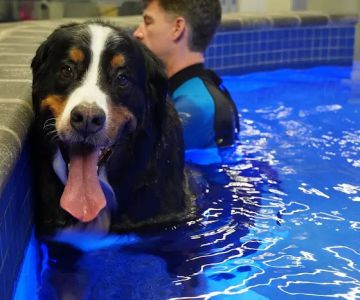Understanding Separation Anxiety in Dogs
As a pet owner, one of the most challenging experiences can be dealing with a dog suffering from separation anxiety. I vividly remember when my dog, Bella, first started showing signs of anxiety when I left the house. At first, I thought it was just a phase, but as the days went by, I noticed she was getting more distressed, and her behavior was becoming more destructive. Chewed-up shoes, barking endlessly, and even accidents inside the house – Bella’s anxiety was taking a toll on both of us. I quickly realized that I had to understand what was happening and find ways to help her feel safe and secure when I was gone.
Separation anxiety is a common issue that many dogs face, and it can happen at any stage of their life. Whether you’ve just adopted a dog or have had one for years, it’s crucial to recognize the signs of anxiety early on. In this article, I will share my experience, offer practical solutions, and provide tips for calming your anxious dog. Let’s dive into what separation anxiety really is and how you can help your dog cope with it.
What is Separation Anxiety in Dogs?
Separation anxiety occurs when a dog becomes overly anxious or stressed when left alone or separated from their primary caregiver. This behavior can manifest in various forms, including destructive behavior, excessive barking, or even physical symptoms like drooling and trembling. The underlying cause is often an emotional attachment to the owner, which makes the dog feel insecure and fearful when they’re left alone.
1. Recognizing the Symptoms of Separation Anxiety
When Bella first started showing signs of separation anxiety, it wasn’t immediately obvious. Initially, it just seemed like she was being a bit clingy. But as time went on, her behavior became more extreme. Here are some key symptoms of separation anxiety to look out for:
- Destructive behavior, like chewing furniture, shoes, or doors.
- Excessive barking or whining when left alone.
- Accidents inside the house, even though the dog is house-trained.
- Drooling, panting, or trembling when anticipating being left alone.
- Attempting to escape from their crate or confined area.
If your dog shows any of these behaviors, especially when you are preparing to leave the house, it could be an indication of separation anxiety. It’s essential to act quickly to prevent these behaviors from becoming more entrenched over time.
2. Causes of Separation Anxiety
Understanding the causes of separation anxiety is key to addressing the issue. In Bella’s case, I discovered that her anxiety stemmed from a traumatic experience she had before I adopted her. She had been abandoned by her previous owner and was placed in a shelter. This experience left her with a deep sense of insecurity. Dogs who have been abandoned, rehomed, or have experienced a significant change in their environment are more likely to develop separation anxiety.
Other common causes include a sudden change in routine, a lack of proper socialization, or even a traumatic event, like a loud noise or a move to a new home. While the exact cause of separation anxiety can vary, the behavior often arises from a lack of confidence and the need for constant reassurance from their owners.
Practical Solutions for Dealing with Separation Anxiety
When it comes to managing separation anxiety in dogs, it’s important to take a calm and gradual approach. While I struggled with Bella’s anxiety at first, I found several strategies that helped her feel more at ease when I had to leave. Here are some effective methods that worked for us:
1. Create a Safe Space
One of the first steps I took was creating a safe and comfortable environment for Bella when I wasn’t home. I set up a cozy area with her bed, some toys, and a blanket that smelled like me. I also started leaving her favorite treat puzzle toys to keep her occupied while I was gone. These toys kept her mentally stimulated and distracted, which helped reduce her anxiety.
2. Gradual Desensitization
Gradual desensitization is one of the most effective techniques for helping dogs with separation anxiety. This involves slowly getting your dog used to being alone in small increments. At first, I started by leaving Bella alone for just a few minutes and gradually increased the time over several weeks. It was important to stay calm and not make a big deal out of my departure or return. By doing so, Bella learned that my leaving wasn’t a stressful event and that I always came back.
3. Use Positive Reinforcement
Positive reinforcement played a huge role in Bella’s progress. I began rewarding her for calm behavior when I left and returned. This helped her associate my departures and arrivals with something positive rather than a stressful event. Every time she stayed calm when I left, I gave her a special treat. Over time, this behavior became more frequent, and Bella learned that she didn’t need to be anxious.
4. Try Calming Products
There are various calming products available that can help alleviate your dog’s anxiety. I tried a few different options, including calming collars, pheromone diffusers, and anxiety wraps. The calming collar worked wonders for Bella, as it released soothing pheromones that helped her relax. Some dogs also benefit from herbal supplements or anxiety-reducing music. These products can be a helpful addition to a comprehensive treatment plan.
5. Professional Help
If your dog’s anxiety is severe, it may be time to seek help from a professional. In Bella’s case, I consulted with a veterinary behaviorist who provided personalized advice and guidance. A professional can help develop a tailored treatment plan, which might include behavior modification techniques or even medication if necessary. Sometimes, separation anxiety is best managed with a multi-faceted approach, and a professional can offer the expertise needed for success.
Real-Life Success Story: Bella’s Journey
When I first adopted Bella, I had no idea how challenging it would be to deal with her separation anxiety. But through patience, consistency, and a lot of trial and error, we made significant progress. Bella now spends time alone without becoming overly anxious, and her destructive behaviors have almost disappeared. While it took time, the journey has been incredibly rewarding, and I’m proud of the progress we’ve made together. If your dog is struggling with separation anxiety, know that it’s possible to help them feel more secure with the right tools and strategies.
Remember, every dog is different, and it may take some time to find what works best for your pet. Stay patient, stay consistent, and don’t hesitate to seek help from a professional if necessary. With the right approach, you can help your dog feel more comfortable when they’re alone and strengthen the bond you share.












